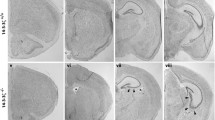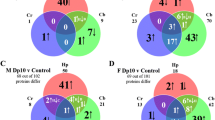Abstract
Down syndrome or trisomy 21 is the most common genetic disorder leading to mental retardation. One feature is impaired short- and long-term spatial memory, which has been linked to altered brain-derived neurotrophic factor (BDNF) levels. Mouse models of Down syndrome have been used to assess neurotrophin levels, and reduced BDNF has been demonstrated in brains of adult transgenic mice overexpressing Dyrk1a, a candidate gene for Down syndrome phenotypes. Given the link between DYRK1A overexpression and BDNF reduction in mice, we sought to assess a similar association in humans with Down syndrome. To determine the effect of DYRK1A overexpression on BDNF in the genomic context of both complete trisomy 21 and partial trisomy 21, we used lymphoblastoid cell lines from patients with complete aneuploidy of human chromosome 21 (three copies of DYRK1A) and from patients with partial aneuploidy having either two or three copies of DYRK1A. Decreased BDNF levels were found in lymphoblastoid cell lines from individuals with complete aneuploidy as well as those with partial aneuploidies conferring three DYRK1A alleles. In contrast, lymphoblastoid cell lines from individuals with partial trisomy 21 having only two DYRK1A copies displayed increased BDNF levels. A negative correlation was also detected between BDNF and DYRK1A levels in lymphoblastoid cell lines with complete aneuploidy of human chromosome 21. This finding indicates an upward regulatory role of DYRK1A expression on BDNF levels in lymphoblastoid cell lines and emphasizes the role of genetic variants associated with psychiatric disorders.



Similar content being viewed by others
Abbreviations
- BDNF:
-
Brain-derived neurotrophic factor
- DS:
-
Down syndrome
- LCLs:
-
Lymphoblastoid cell lines
References
Antonarakis SE, Lyle R, Dermitzakis ET, Reymond A, Deutsch S (2004) Chromosome 21 and down syndrome: from genomics to pathophysiology. Nat Rev Genet 5:725–738
Brugge KL, Nichols SL, Salmon DP, Hill LR, Delis DC, Aaron L et al (1994) Cognitive impairment in adults with Down's syndrome: similarities to early cognitive changes in Alzheimer's disease. Neurology 44:232–238
Lebmann V (1998) Neurotrophin-dependent modulation of glutamatergic synaptic transmission in the mammalian CNS. Gen Pharmacol 31:667–674
Pezet S, Malcangio M (2004) Brain-derived neurotrophic factor as a drug target for CNS disorders. Expert Opin Ther Targets 8:391–399
Bimonte-Nelson HA, Hunter CL, Nelson ME, Granholm AC (2003) Frontal cortex BDNF levels correlate with working memory in an animal model of Down syndrome. Behav Brain Res 139:47–57
Fukuda Y, Berry TL, Nelson M, Hunter CL, Fukuhara K, Imai H et al (2010) Stimulated neuronal expression of brain-derived neurotrophic factor by neurotropin. Mol Cell Neurosci 45:226–233
Bianchi P, Ciani E, Guidi S, Trazzi S, Felice D, Grossi G et al (2010) Early pharmacotherapy restores neurogenesis and cognitive performance in the Ts65Dn mouse model for Down syndrome. J Neurosci 30:8769–8779
Toiber D, Azkona G, Ben-Ari S, Torán N, Soreq H, Dierssen M (2010) Engineering DYRK1A overdosage yields Down syndrome-characteristic cortical splicing aberrations. Neurobiol Dis 40:348–359
Guedj F, Sébrié C, Rivals I, Ledru A, Paly E, Bizot JC et al (2009) Green tea polyphenols rescue of brain defects induced by overexpression of DYRK1A. PLoS One 4:e4606
Dierssen M, de Lagrán MM (2006) DYRK1A (dual-specificity tyrosine-phosphorylated and -regulated kinase 1A:a gene with dosage effect during development and neurogenesis. Sci World J 6:1911–1922
Altafaj X, Dierssen M, Baamonde C, Martí E, Visa J, Guimerà J et al (2001) Neurodevelopmental delay, motor abnormalities and cognitive deficits in transgenic mice overexpressing Dyrk1A (minibrain), a murine model of Down's syndrome. Hum Mol Genet 10:1915–1923
Terracciano A, Sanna S, Uda M, Deiana B, Usala G, Busonero F et al (2010) Genome-wide association scan for five major dimensions of personality. Mol Psychiatry 15:647–656
Aït Yahya-Graison E, Aubert J, Dauphinot L, Rivals I, Prieur M, Golfier G et al (2007) Classification of human chromosome 21 gene-expression variations in Down syndrome: impact on disease phenotypes. Am J Hum Genet 81:475–491
Dogliotti G, Galliera E, Licastro F, Corsi MM (2010) Age-related changes in plasma levels of BDNF in Down syndrome patients. Immun Ageing 25:7–12
Fujimura H, Altar CA, Chen R, Nakamura T, Nakahashi T, Kambayashi J et al (2002) Brain-derived neurotrophic factor is stored in human platelets and released by agonist stimulation. Thromb Haemost 87:728–734
Donovan MJ, Miranda RC, Kraemer R, McCaffrey TA, Tessarollo L, Mahadeo D et al (1995) Neurotrophin and neurotrophin receptors in vascular smooth muscle cells. Regulation of expression in response to injury. Am J Pathol 147:309–324
Nakahashi T, Fujimura H, Altar CA, Li J, Kambayashi J, Tandon NN et al (2000) Vascular endothelial cells synthesize and secrete brain-derived neurotrophic factor. FEBS Lett 470:113–117
Kerschensteiner M, Gallmeier E, Behrens L, Leal VV, Misgeld T, Klinkert WE et al (1999) Activated human T cells, B cells, and monocytes produce brain-derived neurotrophic factor in vitro and in inflammatory brain lesions: a neuroprotective role of inflammation? J Exp Med 189:865–870
Kermani P, Hempstead B (2007) Brain-derived neurotrophic factor: a newly described mediator of angiogenesis. Trends Cardiovasc Med 17:140–143
Lommatzsch M, Zingler D, Schuhbaeck K, Schloetcke K, Zingler C, Schuff-Werner P et al (2005) The impact of age, weight and gender on BDNF levels in human platelets and plasma. Neurobiol Aging 26:115–123
Pruunsild P, Kazantseva A, Aid T, Palm K, Timmusk T (2007) Dissecting the human BDNF locus: bidirectional transcription, complex splicing, and multiple promoters. Genomics 90:397–406
Yang EJ, Ahn YS, Chung KC (2001) Protein kinase Dyrk1 activates cAMP response element-binding protein during neuronal differentiation in hippocampal progenitor cells. J Biol Chem 276:39819–39824
Arron JR, Winslow MM, Polleri A, Chang CP, Wu H, Gao X et al (2006) NFAT dysregulation by increased dosage of DSCR1 and DYRK1A on chromosome 21. Nature 441:595–600
Tao X, Finkbeiner S, Arnold DB, Shaywitz AJ, Greenberg ME (1998) Ca2+ influx regulates BDNF transcription by a CREB family transcription factor-dependent mechanism. Neuron 20:709–726
Groth RD, Mermelstein PG (2003) Brain-derived neurotrophic factor activation of NFAT (nuclear factor of activated T-cells)-dependent transcription: a role for the transcription factor NFATc4 in neurotrophin-mediated gene expression. J Neurosci 23:8125–8134
Ahmed MM, Sturgeon X, Ellison M, Davisson MT, Gardiner KJ (2012) Loss of correlations among proteins in brains of the Ts65Dn mouse model of Down syndrome. J Proteome Res 11:1251–1263
Lang UE, Hellweg R, Kalus P, Bajbouj M, Lenzen KP, Sander T et al (2005) Association of a functional BDNF polymorphism and anxiety-related personality traits. Psychopharmacology 180:95–99
Virji-Babul N, Eichmann A, Kisly D, Down J, Haslam RH (2007) Use of health care guidelines in patients with Down syndrome by family physicians across Canada. Paediatr Child Health 12:179–183
Acknowledgments
Measurement of BDNF level was performed on the FlexStation3 Facility of the Functional and Adaptative Biology (BFA) laboratory. This work was supported by a FP6 EU grant AnEUploidy, the Fondation Jérome Lejeune, and the Agence Nationale de la Recherche (MNP grant).
Financial Disclosures
None.
Author information
Authors and Affiliations
Corresponding author
Additional information
Jean-Maurice Delabar and Nathalie Janel share senior authorship.
Rights and permissions
About this article
Cite this article
Tlili, A., Hoischen, A., Ripoll, C. et al. BDNF and DYRK1A Are Variable and Inversely Correlated in Lymphoblastoid Cell Lines from Down Syndrome Patients. Mol Neurobiol 46, 297–303 (2012). https://doi.org/10.1007/s12035-012-8284-7
Received:
Accepted:
Published:
Issue Date:
DOI: https://doi.org/10.1007/s12035-012-8284-7




